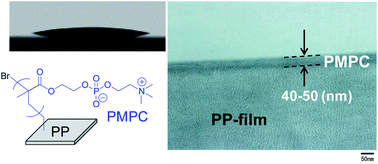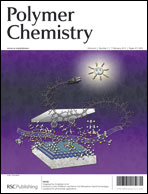Direct modification of polyolefin films by surface-initiated polymerization of a phosphobetaine monomer†
Abstract
The surfaces of polyethylene and polypropylene sheets were modified by grafting with polymeric brushes formed from a phosphobetaine monomer. Pressed sheets of bromo-functionalized polyethylene or polypropylene macroinitiators (PE-MIs and PP-MIs, respectively) were used to initiate the atom-transfer radical polymerization of 2-(methacryloyloxy)ethyl phosphorylcholine (MPC) under mild conditions to form a superhydrophilic grafted surface layer. The grafted polyolefin sheets showed excellent wettability and oil-detachment behaviour in


 Please wait while we load your content...
Please wait while we load your content...